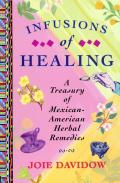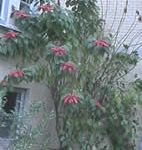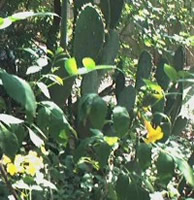Infusions of Healing, by Joie Davidow
reviewed 2005-01-25 by Rosemarie L. Coste

One of the great things about natural topical treatments, as opposed to those which must be ingested or injected, is that they are often easy: easy to apply, easy to monitor for their effect, easy to remove if the effect is irritating, and easy to create. Treatment with Aloe vera may be the easiest of all: snap off a leaf from the live plant, squeeze the oozing gel onto burned skin, and the burn will almost instantly feel and look better.
Topical herbal treatments, like the simple application of aloe gel to a burn, may be some of the oldest and most time-tested medicine we have. Aloe, an African plant which was brought to the Americas by the Spanish and has naturalized here, has long been widely popular as a healing plant, kept handy in kitchens and gardens and included as an ingredient in many storebought lotions and creams; even consumers most skeptical of herbal remedies are likely to trust and use aloe. It is, after all, tried and true.
In Infusions of Healing: A Treasury of Mexican-American Herbal Remedies (Simon & Schuster, 1999), Joie Davidow explores a long tradition of successful remedies using aloe and many other plants, native and naturalized, that are plentiful in Mexico and the Southwestern United States. Having lived in Texas most of my life and kept a garden most of that time, I thought I was well aware of our local medicinal plants. Thanks to Davidow’s book, I learned that there are plants in my garden with attributes I had not properly appreciated. For example, I didn’t know that the plant I call “esperanza” or Tecoma stans (also named tronadora, retama, yellowbells, trumpet bush) is a treatment for adult-onset diabetes, nor that prickly pear (Opuntia, “nopal” or “tuna”, in Spanish), is also a diabetes treatment, as well as a treatment for toothache, canker sores, and other wounds. I didn’t know that the Mexican oregano (Yerba dulce, Origanum) is an antiseptic, used against earache, toothache, snakebite, and itchy skin. I knew that nochebuena (Euphorbia, poinsettia) is toxic and should never be ingested, but not that its sap is used to remove body hair and its leaves are used to treat skin inflammations. There may be unknown treasures in every garden; it’s good to be reminded to keep an eye out for them.

In addition to listing plants and their traditional uses as home remedies, Davidow provides something special: historical context. Beginning with the Aztecs, she follows Mexican herbal lore on its journey through medieval European medical literature and back into the current practices of yerberas and curanderas and the stocked shelves of neighborhood botánicas. The organization of the book reflects this effort to discuss herbs not in isolation but as part of a study of a culture; the herbs are used to illuminate the story of how and why and by whom they have come to be used.
Part I, “Five Centuries of Healing”, is primarily a historical review; it begins with Aztec healing practices and concludes with profiles of some yerberas, herbal healers, practicing today in East Los Angeles.
Part II, “Plantas Que Curan: Healing Plants and Their Uses”, introduces the Nahuatl vocabulary used by the Aztecs to name plants, then discusses a wide selection (140 pages) of plants identified by their botanical names and their English, Spanish, and Nahuatl names; some lucky plants are illustrated with beautiful line drawings by Miro Salazar. The section concludes with profiles of professional healers in Texas, California, and New Mexico.
Part III, “Preparations for Herbs”, includes general instructions for processing herbs into usable formulations as infusions, decoctions, macerations, tinctures, infused oils, salves, ointments, liniments, compresses, and poultices.
Part IV, “Los Remedios: Traditional Treatments for Common Ailments” includes specific recipes, organized by ailment, formulating herbs into treatments to address a variety (100 pages) of problems. The section on “Herbs for the Skin”, for example, suggests recipes to treat skin irritation and rashes, wounds and abrasions, cuts and scratches, stings and bites, boils and abscesses, burns, and sunburn. Many of the plants suggested in this section (avocado, lemon, guava, calendula, spearmint, flaxseed) are widely available in grocery stores and nurseries; others (mesquite, oak, prickly pear, aloe vera) can often be found growing wild in the Southwest; many others might not be available at all in areas without a sizeable Mexican American population. Fortunately, the final sections of the book list botánicas that take mail and telephone orders, as well as print and online resources for further reading. A table cross-referencing the many names by which the plants are known is also provided; all these will make it easier to track down hard-to-find herbs.

The book concludes with an invitation to “Please visit our Web site: www.infusionsofhealing.com.” There’s nothing to see at that site, though, but an “under construction” notice and a list of links to providers of services related (alternative health, natural healing, holistic healing) and unrelated (internet service, web design, online business degrees) to the book’s subject matter. Perhaps something will appear there in the future, although that seems an unlikely development in 2005 for a book published in 1999; for now, the author’s site at http://www.joiedavidow.com/ provides an excerpt of the text, a sample illustration, and a link from which to purchase the book.
The book concludes with an invitation to “Please visit our Web site: www.infusionsofhealing.com.” There’s nothing to see at that site, though, but an “under construction” notice and a list of links to providers of services related (alternative health, natural healing, holistic healing) and unrelated (internet service, web design, online business degrees) to the book’s subject matter. Perhaps something will appear there in the future, although that seems an unlikely development in 2005 for a book published in 1999; for now, the author’s site at http://www.joiedavidow.com/ provides an excerpt of the text, a sample illustration, and a link from which to purchase the book.
